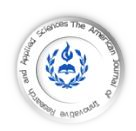
GENERAL INFORMATION

| ISSN: 2429-5396 (e) | www.american-jiras.com | |
| Web Site Form: v 0.1.05 | JF 22 Cours, Wellington le Clairval, Lillebonne | France |
| Web Site Form: v 0.1.05 | JF 22 Cours, Wellington le Clairval, Lillebonne | France |

| HOME | ABOUT US | ARCHIVE | AIMS AND SCOP | AUTHORS | REVIEW | SUMIBMIT MANUSCRIPT | EDITORIAL BOARED | PUBLICATION FEE |
| | ARTICLES | Am. J. innov. res. appl. sci. Volume 11, Issue 2, Pages 126-130 (August, 2020) |
| Research Article 8 |


|
American Journal of innovative
Research & Applied Sciences
Research & Applied Sciences
ISSN 2429-5396 (Online)
OCLC Number: 920041286
OCLC Number: 920041286
| HOME || ABOUT US || ARCHIVES || AIMS AND SCOP || AUTHORS || REVIEW|| SUBMIT MANUSCRIPT || EDITORIAL BOARD || CONTACT US |

| AAUGUST | VOLUME 11 | N° 2 | 2020 |

| Info-AJIRAS-® Journal ISSN 2429-5396 (Online) / Reference CIF/15/0289M |
American Journal of Innovative Research & Applied Sciences
Authors Contact
*Correspondant author and authors Copyright © 2020:
| Emem Okon Mbong 1* | Ekom Ndifreke Edem 2 | Sajjad Hussain 3 | and | Mfon Emmanuel Ntekpe 4 |
Affiliation.
1. Department of Environmental Biology | Heritage Polytechnic | Ikot Udoata, Eket, | Nigeria |
2. Department of Medical Microbiology | University of Uyo Teaching Hospital, Uyo, | Nigeria |
3. Department of Microbiology | Harbin Medical University | Harbin, | China |
4. Department of Microbiology | Heritage Polytechnic | Ikot Udoata, Eket, | Nigeria |
This article is made freely available as part of this journal's Open Access: ID | Mbong-Ref1-ajira180720 |
*Correspondant author and authors Copyright © 2020:
| Emem Okon Mbong 1* | Ekom Ndifreke Edem 2 | Sajjad Hussain 3 | and | Mfon Emmanuel Ntekpe 4 |
Affiliation.
1. Department of Environmental Biology | Heritage Polytechnic | Ikot Udoata, Eket, | Nigeria |
2. Department of Medical Microbiology | University of Uyo Teaching Hospital, Uyo, | Nigeria |
3. Department of Microbiology | Harbin Medical University | Harbin, | China |
4. Department of Microbiology | Heritage Polytechnic | Ikot Udoata, Eket, | Nigeria |
This article is made freely available as part of this journal's Open Access: ID | Mbong-Ref1-ajira180720 |
ABSTRACT
Background: Waterborne fungi are associated with variety of health related conditions and this situation draws more concern a because of increasing numbers of immunosuppressed patients. Nonetheless, aside from the pathogenic Fungi, some of them are critically important as mutualistic symbionts with plants and animals, nutrient recyclers and bioconverters and food sources for the growing human population. Hence, knowledge of fungal communities associated with different water bodies is vital. In spite of these, literature on fungal diversity in this area (Onna L.G.A.) is scanty. Objective: Hence, the present study seeks to investigate the fungal distribution and diversity in Ikwe Pond, located in the study Area using standard scientific methodology. Methods: A total of thirty different water points were sampled using 30 thoroughly washed 0.50L sterile plastic containers and cultured on SDA plates with 1ml of dilution factors 10-3 and 10-6 used as inoculums. Results: Six fungal species namely Candida tropicalis, Aspergillus niger. Cryptococcus sp, Absidia sp, Geotricium sp, was isolated from the 30 sampling points. Upstream recorded a total of 27 spores, midstream had 14 spores while downstream recorded 8 spores. Also the colony count revealed that upstream had the highest number of fungal spores count. Clearly, the upstream (59.3%) and the midstream (78.6%) sampling points were dominated by Aspergillus niger while the downstream water column was dominated by Candida tropicalis (50%). Conclusion: This result concludes the water body contains numerous pathogenic fungi which can lead to severe health related issues. To this end, periodic monitoring of the abundance and distribution of fungi in this and other water bodies is needful.
Keywords: Fungi, Ikwe, pond, Upstream, Aquatic, Ecosystem, Health
Background: Waterborne fungi are associated with variety of health related conditions and this situation draws more concern a because of increasing numbers of immunosuppressed patients. Nonetheless, aside from the pathogenic Fungi, some of them are critically important as mutualistic symbionts with plants and animals, nutrient recyclers and bioconverters and food sources for the growing human population. Hence, knowledge of fungal communities associated with different water bodies is vital. In spite of these, literature on fungal diversity in this area (Onna L.G.A.) is scanty. Objective: Hence, the present study seeks to investigate the fungal distribution and diversity in Ikwe Pond, located in the study Area using standard scientific methodology. Methods: A total of thirty different water points were sampled using 30 thoroughly washed 0.50L sterile plastic containers and cultured on SDA plates with 1ml of dilution factors 10-3 and 10-6 used as inoculums. Results: Six fungal species namely Candida tropicalis, Aspergillus niger. Cryptococcus sp, Absidia sp, Geotricium sp, was isolated from the 30 sampling points. Upstream recorded a total of 27 spores, midstream had 14 spores while downstream recorded 8 spores. Also the colony count revealed that upstream had the highest number of fungal spores count. Clearly, the upstream (59.3%) and the midstream (78.6%) sampling points were dominated by Aspergillus niger while the downstream water column was dominated by Candida tropicalis (50%). Conclusion: This result concludes the water body contains numerous pathogenic fungi which can lead to severe health related issues. To this end, periodic monitoring of the abundance and distribution of fungi in this and other water bodies is needful.
Keywords: Fungi, Ikwe, pond, Upstream, Aquatic, Ecosystem, Health
Corresponding author Author and Copyright Author © 2020: | Emem Okon Mbong 1* | |. All Rights Reserved. All articles published in American Journal of Innovative Research and Applied Sciences are the property of
Atlantic Center Research Sciences, and is protected by copyright laws CC-BY. See: http://creativecommons.org/licenses/by-nc/4.0/
DIVERSITY AND DISTRIBUTION OF FUNGI ASSOCIATED WITH “IKWE POND” WATER SOURCE: THEIR IMPACT ON WATER QUALITY AND HUMAN HEALTH
| Emem Okon Mbong 1* | Ekom Ndifreke Edem 2 | Sajjad Hussain 3 | and | Mfon Emmanuel Ntekpe 4 |. Am. J. innov. res. appl. sci. 2020; 11(2):126-131.
| PDF FULL TEXT | | XML FILE | | Received | July 15, 2020 | | Accepted | July 26, 2020 | | Published | August 01, 2020 |
| Emem Okon Mbong 1* | Ekom Ndifreke Edem 2 | Sajjad Hussain 3 | and | Mfon Emmanuel Ntekpe 4 |. Am. J. innov. res. appl. sci. 2020; 11(2):126-131.
| PDF FULL TEXT | | XML FILE | | Received | July 15, 2020 | | Accepted | July 26, 2020 | | Published | August 01, 2020 |